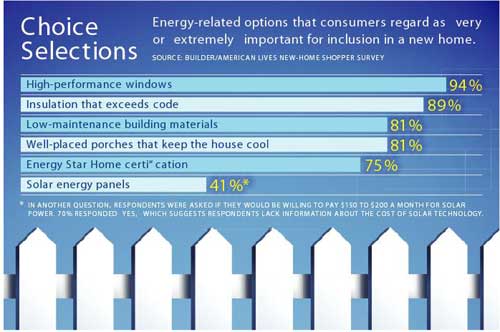Dreaming in Color.
Builders and immigrants both see their future in homeownership. But they don’t always see it the same way. Through this decade, immigrants accounted for 29% of America’s household growth, up from 19% in the 1990s and 10% in the 1980s.
While by no means monolithic, immigrant buyer groups do share characteristics that builders can latch onto. Foremost is the centrality of family and how that affects what homes they will consider buying. Another is their penchant for bigger homes with decent-sized yards to accommodate large and extended families. “Large,” though, doesn’t mean “McMansion” for immigrant buyers. It usually has more to do with room count.
Realtors and demographers say Hispanics tend to gravitate toward existing homes they can fix up or upgrade. By contrast, Asians lean toward new homes. And while it’s rarely a deal breaker, some Asians desire homes that are built to the aesthetic system known as Feng Shui. That system touches upon everything from the house’s position to the sun, how the front and back doors open, whether its interior corners are finished, where toilets are located, even the house’s color and its street address numbers.
That being said, buying a home in the U.S. is still confusing and intimidating for many immigrant buyers. Not surprisingly, they look for someone they can trust. Builders who want to tap into these groups must acknowledge the role that Realtors play as confidants and guides through the home search and buying process.
Redesigning Retirement.
By 2011, half of all homeowners will be over 50. But the current housing landscape doesn’t necessarily provide what they want–or need.
“If the houses that were selling last year were 2,500 to 2,700 square feet with a finished bonus room, maybe now I need to scale back by 220 square feet,” says Steve Romeyn, co-founder of Windsong Properties, a builder of active adult communities in the suburbs outside of Atlanta. “But I can’t switch from tile to vinyl floors or from granite countertops back to laminate. The mature buyer still wants quality.
“It’s like choosing between the BMW 3 series and the 5 series. If you sit in those cars, the only difference is the size, not the quality of the leather.”
Numerous studies of Boomers cite a common desire for single-story plans, low-maintenance living, high design, and the ability to live near their kids. In a recent AARP survey, 79% of participants said they wanted to “stay in their current home for as long as possible.” The problem is that many of these existing homes and communities never were designed for aging in place. And with the number of persons 65 and older expected to reach 40 million by next year, those shortcomings are becoming more apparent.
Hear Them Roar.
By the sheer force of their numbers–which is reportedly between 80 million and 90 million–Millennials are poised to change the home buying and building landscape. Builders who ignore this group do so at their peril.
The good news is Millennials favor homeownership and believe in its importance in wealth creation. But Millennials are different.
Demographers say Millennials generally prefer urban locations, or at least denser environments, over distant suburbs. Location is even more of a driver for Millennials than for their parents. And ideal locations need not be in downtown urban cores. Suburban-based density is just as attractive to some buyers, demographers and builders say.
Builders also should get to know female buyers. By 2010, households headed by a woman will top 30 million, and many are buying their own homes. Safety is very important to them, but they still want to be able to walk to shopping and dining.
To read the complete stories, side features and survey results, visit www.builderonline.com/brave-new-world.



